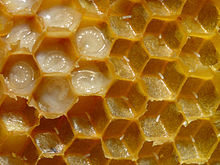A honeycomb is a mass of hexagonal wax cells built by honey bees in their nests to contain their larvae and stores of honey and pollen.
Beekeepers may remove the entire honeycomb to harvest honey. Honey bees consume about 8.4 lbs (4 kg) of honey to secrete 1 lb (500 g) of wax, so it makes economic sense to return the wax to the hive after harvesting the honey, commonly called “pulling honey” or “robbing the bees” by beekeepers. The structure of the comb may be left basically intact when honey is extracted from it by uncapping and spinning in a centrifugal machine—the honey extractor. If the honeycomb is too worn out, the wax can be reused in a number of ways, including making sheets of comb foundation with hexagonal pattern. Such foundation sheets allow the bees to build the comb with less effort, and the hexagonal pattern of worker-sized cell bases discourages the bees from building the larger drone cells.
“Artificial honeycomb” plate where bees have already completed some cells
Fresh, new comb is sometimes sold and used intact as comb honey, especially if the honey is being spread on bread rather than used in cooking or to sweeten tea.
Broodcomb becomes dark over time, because of the cocoons embedded in the cells and the tracking of many feet, called travel stainby beekeepers when seen on frames of comb honey. Honeycomb in the “supers” that are not allowed to be used for brood (e.g. by the placement of a queen excluder) stays light coloured.
Numerous wasps, especially Polistinae and Vespinae, construct hexagonal prism-packed combs made of paper instead of wax; and in some species (such as Brachygastra mellifica), honey is stored in the nest, thus technically forming a paper honeycomb. However, the term “honeycomb” is not often used for such structures.
Honeycomb geometry
Honeycomb with eggs and larvae
The bees begin to build the comb from the top of each section. When a cell is filled with honey, the bees seal it with wax.
Closeup of an abandoned Apis floreanest, Thailand – the hexagonal grid of wax cells on either side of the nest are slightly offset from each other. This increases the strength of the comb and reduces the amount of wax required to produce a robust structure.
The axes of honeycomb cells are always quasi-horizontal, and the nonangled rows of honeycomb cells are always horizontally (not vertically) aligned. Thus, each cell has two vertical walls, with “floors” and “ceilings” composed of two angled walls. The cells slope slightly upwards, between 9 and 14 degrees, towards the open ends.
There are two possible explanations for the reason that honeycomb is composed of hexagons, rather than any other shape. One, given by Jan Brożek and proved much later by Thomas Hales, is that the hexagon tiles the plane with minimal surface area. Thus, a hexagonal structure uses the least material to create a lattice of cells within a given volume. Another, given by D’Arcy Wentworth Thompson, is that the shape simply results from the process of individual bees putting cells together: somewhat analogous to the boundary shapes created in a field of soap bubbles. In support of this, he notes that queen cells, which are constructed singly, are irregular and lumpy with no apparent attempt at efficiency. The closed ends of the honeycomb cells are also an example of geometric efficiency, albeit three-dimensional and little-noticed. The ends are trihedral (i.e., composed of three planes) sections of rhombic dodecahedra, with the dihedral angles of all adjacent surfaces measuring 120°, the angle that minimizes surface area for a given volume. (The angle formed by the edges at the pyramidal apex, known as the tetrahedral angle, is approximately 109° 28′ 16″ (= cos(−1/3)).)


